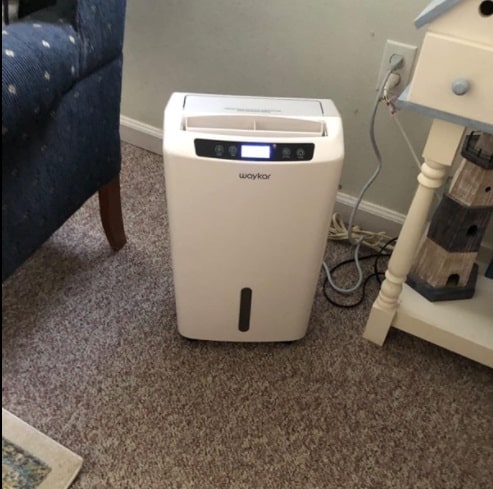Excessive humidity in your home can cause a lot of problems for the structural integrity of your house as well as the health of you and your family. A dehumidifier is the solution to removing moisture from the air, and you can find models for every room in your home, but can one dehumidifier in the basement help the entire house?
A basement dehumidifier designed to work in low temperatures with proper square-foot and pint rating can work for your entire home. Whole-house dehumidifiers can also be professionally attached to an HVAC system to help keep the humidity at optimal levels in your entire home.
Read on to find out how to find a basement dehumidifier that will work to remove excessive dampness in your whole house effectively. Learn what aspects you need to consider when shopping for a dehumidifier. I have also put together a table with features and ratings to help you choose the best dehumidifier for your needs.
What Type of Dehumidifier Can Work for the Entire House?
The basement is the most common area of your home that experiences high moisture levels, so many people opt for a basement dehumidifier to address the problem. If you have excessive humidity in other areas of your home, you can choose to purchase small dehumidifiers for each room. However, for the sake of convenience and ease of maintenance, you may prefer to buy a single dehumidifier unit that stays in the basement and out of sight.
The standard dehumidifier used for basement moisture issues is portable. As the name suggests, this model can be easily moved and stored. Some homeowners opt to purchase a dehumidifier that attaches to an HVAC system and requires professional installation. Let’s look into the pros and cons of each, and then I will give you a handy table to compare models and the features that best suit your needs.
The pros of using a portable dehumidifier:
- Affordability
- Small size
- Easily moved around the house as needed
- Easy to set up

The cons of using a portable dehumidifier:
- Difficult to find replacement parts
- Not as effective in dehumidifying large houses with multiple levels
- Multiple units may be required to address all rooms of your home
- Small water reservoir that needs to be emptied daily
When you are looking for a dehumidifier unit that can address high humidity in your entire house, you will want to select a whole-house dehumidifier. This type of dehumidifier can be installed in your basement or whichever area of your home you prefer and will work to lower the humidity levels of your entire house.
The pros of using a whole-house dehumidifier:
- Only one unit is needed
- Can manage humidity in your entire home
- Can decrease humidity quickly
- Tend to be low maintenance
- Connects to a drain; no water reservoir to empty

The cons of using a whole-house dehumidifier:
- Can be expensive
- It Will require more space, which may limit where you can install it
- Requires hiring a professional for installation (DYI may void the warranty!)
- Conventional whole-house dehumidifiers need to be in temperatures of at least 65 degrees to operate properly
As you can see, there are pros and cons to both types of dehumidifiers, but if you are looking for one unit that will work for your entire home, a whole-house dehumidifier is the way to go.
What to Know When Purchasing a Whole-House Dehumidifier
Since a whole-house dehumidifier needs to be installed correctly in your basement, there is more to consider than when purchasing a portable unit.
Here are some things to keep in mind when shopping for a whole-house dehumidifier:
- You will most likely need to consult with an HVAC professional to have the dehumidifier properly installed.
- If you are planning to have the dehumidifier installed in your basement, you will need to select a specifically designed unit to work at temperatures lower than 65 degrees. Your typical basement averages 55 degrees which may be too low for a conventional whole-house dehumidifier.
- For less maintenance, select a basement dehumidifier with an automatic draining feature; otherwise, you will have to empty out a reservoir when water collects, just like with a portable dehumidifier. (see table below for specific features)
Use the above guidelines while shopping for a whole-house dehumidifier. You can save yourself some potential headaches from picking an incompatible unit or underestimating the amount of work it may take to install.
How Do I Know if I Need a Dehumidifier for My Home?
For some homes, the basement is the only area suffering from excess moisture, so you won’t necessarily require a dehumidifier for your entire house.
Any underground areas of your home are more susceptible to high humidity due to:
- Rain or ground-water seeping in through cracks in the foundation
- Poor insulation
- Leaking pipes
- Unvented clothes dryers
Addressing the root cause of excessive humidity can help solve your problem, but using a dehumidifier may be an easier and more cost-effective solution.
Here are some ways to know if your moisture problem is confined to the basement or has affected the rest of your home. If you notice any of the below conditions in the above-ground areas of your house, it would be beneficial to start using a dehumidifier.
- The humidity level is above 50%. The recommended humidity level for a home is between 30% and 50%.
- Your home feels stuffy, and there is a damp residue on the walls.
- There is condensation on the walls or other surfaces.
- You can see mold growing on the ceiling or in the corners. Mold can be fairly common in the bathroom because of the humidity from hot showers and baths, but if you are noticing mold in other rooms of your home, the humidity is higher than recommended.
- Your home smells musty or stale.
- The wallpaper is peeling off.
- Creaky floors or cabinets can be a sign that the wood has absorbed excessive moisture.
- You notice watermarks on your floors.
If you notice any of the above signs in your basement or underground areas of your home, you can easily get an affordable dehumidifier that will take care of the problem. However, if you see signs of high humidity in the above-ground areas of your house, you may want to consider the convenience of a whole-house dehumidifier.
You can also check the humidity levels in your home with a multi-room hygrometer, which can be found at your local hardware store or here on Amazon. These devices resemble thermometers, but instead of measuring the temperature, they measure the air’s moisture levels. If you purchase a dehumidifier, it will likely have a built-in hygrometer so the unit can be set for your desired humidity level.
What Can Happen if I Don’t Use a Dehumidifier for Excess Humidity in My Home?
If you have high humidity levels in your home but don’t address the problem with a dehumidifier, you can run into some future problems that could end up being quite costly.
Excess humidity in your home can lead to:
- Bacterial growth
- Dust mites
- Mold
- Mildew
These side effects of high humidity in your home can also aggravate allergies, asthma, and respiratory problems. If anyone in your home is vulnerable, you’ll definitely want to use a dehumidifier to regulate the humidity level.
An air conditioner can also be used to decrease the humidity level by drying the air. If you would also like to cool the area, you are dehumidifying, running an air conditioner would be a good option. For colder months, a dehumidifier may be the preferred choice.
A Whole-House Dehumidifier Can Address Humidity Levels in Your Entire Home
For the sake of convenience and aesthetics, a whole-house dehumidifier is the recommended solution for tackling high humidity in your entire house. You will only need to manage one unit, and it can stay in your basement or other areas of your choice. For further convenience, choose a dehumidifier with an automatic draining feature (a hose attachment into a floor drain will spare you the need to empty the unit’s reservoir daily).
Here is a table with top-rated whole-house dehumidifiers with features and notes to help you choose the best dehumidifier for your needs:
| Dehumidifier Brand & Model | Sq ft rating‡ | Pints Per Day Rating‡‡ | Reservoir Tank Size (Pints) ‡‡‡ | Drain Hose* | Unit Size** | Weight (lbs)** | Professional Installation? | Noise Level | Price USD*** | Notes |
| Midea MAD20C1ZWS | 1500-4500 | 20-50 | 6.4-12.8 | Yes | 16” x 12” x 25” | 33 lbs | No | Medium 51db | $175-220 | Highly rated. Has reusable air filter. Look for coupon to save more on Amazon |
| Waykar | 2000 | 34 Pints | 6.4 Pints | Yes | 12.2” X 9” X 19.7” | 33.1 | No | Quite | $170 | For longer life, Leave unit upright for 24 hours before turning the power on for the first time. |
| Colzer | 4000 | 70 | 7.4 | Yes | 11.4” x 11.4” x 23.8” | 29 lbs | No | Quite 42db | $250 | This unit is effective yet easy to move. Look for coupon to save more on Amazon |
| Aprilaire 1850 | 2800-7200 | 70-130 | No Reservoir | Yes | 30” x 20” x 18.75” | 70-114 | Yes | High | $940-$1660 | Use a professional installer. Otherwise, you may void the warranty. |
| COLZER 232 PPD | 8000 | 230 | No Reservoir | Yes | 21.7” x 23.4” x 38” | 105 lbs | No | High | $1000 | This unit is an industrial-strength unit—ideal for water-damaged or flooded areas. |
‡ Maximum rating. For better operation, choose a higher-rated unit.
‡‡ For reference, 8 pints equal to one gallon.
‡‡‡ In high humidity home, you may need to empty the reservoir 3-4 times per day unless you use a drain hose!
* Hose may not be included with the unit
** Approximate sizes and weights. Most units have wheels for easy movement despite the size or weight
*** Prices at the time of writing (April 2021). Add installation cost to Aprilaire 1850
Remember, if you would prefer that the unit be installed in your basement, be sure to purchase a low temperature or basement dehumidifier that can operate in temperatures under 65 degrees. If you follow these tips, you will be on your way to improving your indoor air quality in no time.

